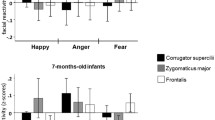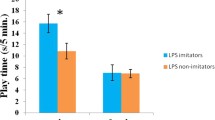Abstract
Spontaneous smiles are facial movements that are characterized by lip corner raises that occur during irregular sleep or drowsiness without known external or internal causes. They are shown by human infants and infant chimpanzees. These smiles are considered to be the developmental origin of smiling and laughter. There are some case studies showing that spontaneous smiles occur in Japanese macaques. The goals of this study were to investigate whether newborn Japanese macaques show a considerable number of spontaneous smiles thus to examine the mechanism of them. Seven newborn Japanese macaques were observed in a room for an average of 44 min, and incidental sleeping situations were monitored twice. All seven participants showed spontaneous smiles at least once during the observation. They showed 8.29 spontaneous smiles in average (SD = 10.89; 58 smiles in total), all found in the state of REM sleep. Thirty-nine of the 58 smiles were produced on the left side of the mouth. These characteristics were similar to those of spontaneous smiles in human infants. This is the first evidence that macaques as well as hominoids show a considerable number of spontaneous smiles. These phenomena may facilitate the development of the zygomaticus major muscle, which is implicated in smiling-like facial expressions.




Similar content being viewed by others
References
Ambrose JA (1961) The development of smiling response in early infancy. In: Foss BM (ed) Determinants of infant behavior. Methuen, London, pp 179–201
Blurton Jones N, Hawkes K, O’Connell JF (1999) Some current ideas about the evolution of the human life history. In: Lee PC (ed) Comparative primate socioecology (Cambridge studies in biological and evolutionary anthropology). Cambridge University Press, Cambridge, pp 140–166
Burrows AM, Waller BM, Parr LA (2009) Facial musculature in the rhesus macaque (Macaca mulatta): evolutionary and functional contexts with comparisons to chimpanzees and humans. J Anat 215:320–334
Cole M, Cole SA (1989) The development of children. Scientific American Books, New York
Darwin C (1872) The expression of the emotions in man and animals. John Murray, London
Davila-Ross M, Jesus G, Osborne J, Bard KA (2015) Chimpanzees (Pan troglodytes) produce the same types of ‘laugh faces’ when they emit laughter and when they are silent. PLoS One 10:e0127337. doi:10.1371/journal.pone.0127337
de Weerd AW, van den Bossche RAS (2003) The development of sleep during the first months of life. Sleep Med Rev 7:179–191
Dondi M, Agnoli S, Franchin L (2010) A new look at the very early origins of smiling. In: Spinozzi P, Zironi A (eds) Origins as a paradigm in the sciences and in the humanities. V&R Unipress, Göttingen, pp 131–146
Ekman P, Friesen WV, Hager JC (2002) Facial action coding system: The manual on CD ROM. Research Nexus Division of Network Information Research Corporation, Salt Lake City
Emde RN, McCartney RD, Harman RJ (1971) Neonatal smiling in REM states VI: premature study. Child Dev 42:1657–1661
Fernández-Carriba S, Loeches Á, Morcillo A, Hopkins WD (2002) Asymmetry in facial expression of emotions by chimpanzees. Neuropsychologia 40:1523–1533
Gunderson VM, Sackett GP (1984) Development of pattern recognition in infant pig-tailed macaques (Macaca nemestrina). Dev Psychol 20:418–426
Hayasaka K, Fujii K, Horai S (1996) Molecular phylogeny of macaques: implications of nucleotide sequences from an 896-base pair region of mitochondrial DNA. Mol Biol Evol 13:1044–1053
Hendrickson A (1992) A morphological comparison of foveal development in man and monkey. Eye 6:136–144
Holsapple MP, West LJ, Landreth KS (2003) Species comparison of anatomical and functional immune system development. Birth Defects Res B 68:321–334
Julle-Danière E, Micheletta J, Whitehouse J, Joly M, Gass C, Burrows AM, Waller BM (2015) MaqFACS (macaque facial action coding system) can be used to document facial movements in Barbary macaques (Macaca sylvanus). PeerJ 3:e1248. doi:10.7717/peerj.1248
Kagan J, Fox N (2006) Biology, culture, and temperamental biases. In: Eisenberg N (ed) Handbook of child development, vol 3, 6th edn. Wiley, New York, pp 167–225
Kawakami F (2009) Phylogeny and ontogeny of spontaneous smiles. J Hum Env Stud 7:67–74 (in Japanese)
Kawakami F, Yanaihara T (2012) Smiles in the fetal period. Infant Behav Dev 35:466–471
Kawakami K, Tomonaga M, Suzuki J (2002) The calming effect of stimuli presentation on infant Japanese macaques (Macaca fuscata) under stress situation: a preliminary study. Primates 43:73–85
Kawakami K, Tomonaga M, Takai K, Mizuno Y, Suzuki J (2003) Spontaneous smiles in newborn Japanese macaques. In: Tomonaga M, Tanaka M, Matsuzawa T (eds) (Cognitive and behavioral development in chimpanzees: a comparative approach) Tinpanji no ninti to koudou no hattatsu. Kyoto University Press, Kyoto, pp 322–326 (in Japanese)
Kawakami K, Takai-Kawakami K, Tomonaga M, Suzuki J, Kusaka F, Okai T (2006) Origins of smile and laughter: a preliminary study. Early Hum Dev 82:61–66
Kawakami K, Takai-Kawakami K, Tomonaga M, Suzuki J, Kusaka F, Okai T (2007) Spontaneous smile and spontaneous laugh: an intensive longitudinal case study. Infant Behav Dev 30:146–152
Kawakami K, Takai-Kawakami K, Kawakami F, Tomonaga M, Suzuki M, Shimizu Y (2008) Roots of smile: a preterm neonates’ study. Infant Behav Dev 31:518–522
Kawakami F, Kawakami K, Tomonaga M, Takai-Kawakami K (2009) Can we observe spontaneous smiles in 1-year-olds? Infant Behav Dev 32:416–421
Lee PC, Majluf P, Gordon IJ (1991) Growth, weaning and maternal investment from a comparative perspective. J Zool 225:99–114
Li J, Han K, Xing J, Kin HS, Rogers J, Ryder OA, Disotell T, Yue B, Batzer MA (2009) Phylogeny of the macaques (Cercopithecidae: Macaca) based on Alu elements. Gene 448:242–249
Masataka N, Fujii H (1980) An experimental study on facial expressions and interindividual distance in Japanese macaques. Primates 21:340–349
Matsusaka T (2004) When does play panting occur during social play in wild chimpanzees? Primates 45:221–229
Messinger D (2008) Smiling. In: Haith MM, Benson JB (eds) Encyclopedia of infant and early childhood development. Academic Press, Oxford, pp 186–198
Messinger D (2009) Smiling. In: Benson JB, Haith MM (eds) Social and emotional development in infancy and early childhood. Academic Press, Oxford, pp 407–420
Mizuno Y, Takeshita H, Matsuzawa T (2006) Behavior of infant chimpanzees during the night in the first 4 months of life: smiling and suckling in relation to behavioral state. Infancy 9:221–240
Palagi E, Mancini G (2011) Playing with the face: Playful facial “chattering” and signal modulation in a monkey species (Theropithecus gelada). J Comp Psychol 125:11–21
Parr LA, Waller BM, Vick SJ, Bard KA (2007) Classifying chimpanzee facial expression using muscle action. Emotion 7:172–181
Parr LA, Waller BM, Burrows AM, Gothard KM, Vick SJ (2010) Brief communication: MaqFACS: a muscle-based facial movement coding system for the rhesus macaque. Am J Phys Anthropol 143:625–630
Povinelli DJ, Prince CG, Preuss TM (2005) Parent-offspring conflict and the development of social understanding. In: Carruthers P, Laurence S, Stich S (eds) The innate mind: structure and contents. Oxford University Press, Oxford, pp 239–253
Preuschoft S (2000) Primate faces and facial expression. Soc Res 67:245–271
Preuschoft J, van Hooff JARAM (1995) Homologizing primate facial displays: a critical review of methods. Folia Primatol 65:121–137
Schmidt-Nielsen K (1984) Scaling: why is animal size so important?. Cambridge University Press, Cambridge
Shimada S (1969) Smiling responses and their developmental significance in neonatal period and infancy. Seishin Shinkeigaku Zasshi 71:741–756 (in Japanese)
Spitz RA, Emde RN, Metcalf (1970) Further prototypes of ego formation: a working paper from a research project on early development. Psychoanal Study Child 25:417–441
Sroufe LA, Waters E (1976) The ontogenesis of smiling and laughter: a perspective on the organization of development in infancy. Psychol Rev 83:173–189
Steiner JE, Glaser D, Hawilo ME, Berridge KC (2001) Comparative expression of hedonic impact: affective reactions to taste by human infants and other primates. Neurosci Biobehav Rev 25:53–74
Takayanagi K (2008) (The medical effect of smiling) Warai no iryoku. Nishimurashoten, Tokyo (in Japanese)
Takeshita H, Myowa-Yamakoshi M, Hirata S (2009) The supine position of postnatal human infants: implications for the development of cognitive intelligence. Interact Stud 10:252–268
van Hooff JA (1972) A comparative approach to the phylogeny of laughter and smiling. In: Hinde RA (ed) Non-verbal communication. Cambridge University Press, Cambridge, pp 209–241
Waller BM, Dunbar RIM (2005) Differential behavioural effects of silent bared teeth display and relaxed open mouth display in chimpanzees (Pan troglodytes). Ethology 111:129–142
Wolff P (1959) Observations on newborn infants. Psychosom Med 21:110–118
Wolff P (1963) Observations on the early development of smiling. In: Foss BM (ed) Determinants of infant behavior, vol 2. Methuen, London, pp 113–138
Acknowledgments
Financial support for this research was provided by JSPS KAKENHI Grant No. 11J07455, 13J00208, 16K21128, 11710035, 13610086, 19300091, 20002001, 23220006, 24000001, and 15H05709. This study was supported by the Cooperative Research Program of the Primate Research Institute, Kyoto University (2000-A-9-1, 2003-B-1, 2007-B-1, 2008-B-15, 2009-B-15, and 2010-B-4). We would like to thank Drs. Tetsuro Matsuzawa, Kiyobumi Kawakami, Kiyoko Takai-Kawakami, and Akifumi Tokosumi for their kind support and suggestions. The experimental procedures used in this study were approved by the Animal Welfare and Animal Care Committee of the Primate Research Institute, Kyoto University, and by the Animal Research Committee of Kyoto University. All procedures adhered to the Japanese Act on the Welfare and Management of Animals.
Author information
Authors and Affiliations
Corresponding author
Electronic supplementary material
Below is the link to the electronic supplementary material.
Supplementary material 1 (MPG 5428 kb)
About this article
Cite this article
Kawakami, F., Tomonaga, M. & Suzuki, J. The first smile: spontaneous smiles in newborn Japanese macaques (Macaca fuscata). Primates 58, 93–101 (2017). https://doi.org/10.1007/s10329-016-0558-7
Received:
Accepted:
Published:
Issue Date:
DOI: https://doi.org/10.1007/s10329-016-0558-7




